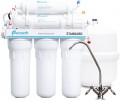Filtration speed
The amount of water that the filter is able to pass through itself per unit of time (of course, effectively purified in the process); usually stated in liters per minute. This parameter is largely related to the type (see above): for example, in jugs, the filtration rate usually does not exceed 0.5 L per minute, while for main devices that supply entire apartments, a throughput of tens or even hundreds of liters is required.
Note that it does not always make sense to pursue a high filtration rate. After all, other things being equal, finer cleaning takes more time; accordingly, the faster the filter works, the higher the chance that the quality of such cleaning will be relatively low. And devices that purify water efficiently and quickly usually have an appropriate price. Therefore, it is worth considering the purpose of the filter and, on the basis of this, determine the balance between the filtration speed and its quality when choosing. It is also worth keeping in mind the conditions of use: for example, if you need to filter low-quality tap water for drinking, it is better to sacrifice speed in favor of efficiency.
Resource
The resource can be described as the total amount of water (in thousands of liters) that the filter is able to clean before the cartridge needs to be changed. Usually, it is indicated for a standard filter element (see "Removable cartridges").
Different types of filters (see above) can significantly differ in resource, depending on the features of their application. However, for all models, the rule applies: do not use a cartridge that has exhausted its resource. This is due not only to a drop in filtration efficiency — an “overfilled” filter can begin to release the accumulated contents into the water, further degrading its quality. Since it can be quite difficult to monitor of a specific amount of treated water, many manufacturers indicate the approximate time in which it will be exhausted with an average intensity of use in addition to the resource. Usually it is a few months, but there are exceptions. In addition, for the convenience of the user, various indicators can be provided in the filter design (see "Cartridge replacement indicator").
In models with a multi-stage design (see "Stages of purification"), where there are several cartridges, their resource usually differs, and the total filter resource is usually indicated by the least durable cartridge, that is, until the first replacement of any of the filter elements.
Fitting size
The diameter of the pipes to which the filter is designed to be connected; indicated only for models with water connection, see "Connection". In plumbing, pipes of standard diameters are usually used, and inches are used for measurement — for example, 0.75", 1", etc. Most filters are equipped with a set of adapters for different pipe diameters, therefore, most likely there will be no connection problems, even if the initial diameters do not match. Nevertheless, it is best to choose a filter that matches your water supply in terms of fitting size — in this case, the connection is more reliable, and compliance with the claimed characteristics will be complete.
Max operating temperature
The highest inlet water temperature at which the filter is able to operate normally. Modern filters are conditionally divided into models for cold and hot water: the operating temperature in the first case does not exceed 40 °C, and in the second it can reach 95 °C. For more information on the importance of matching water temperature and filter characteristics, see "Purpose".
Replacement cartridges
Models of replaceable cartridges for which the filter is designed. Knowing the names of models, it will be much easier for you to find a replacement for an exhausted cartridge. In addition, the options directly named by the manufacturer are fully compatible with the filter and correspond to official specifications, while there is no such guarantee for "non-native" cartridges.
Several names in this paragraph are usually indicated for filters with multi-stage filtration (see "Stages of purification") — a cartridge for each stage.
Tank volume
The capacity of the reverse osmosis tank. The higher the value, the more water can be filtered for future use. Popular sizes include
a 12 L tank and
a 15 L tank. Only in this case the dimensions for installing the filter will become larger. Accordingly, more is not always better. And yes, it affects the price.

